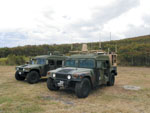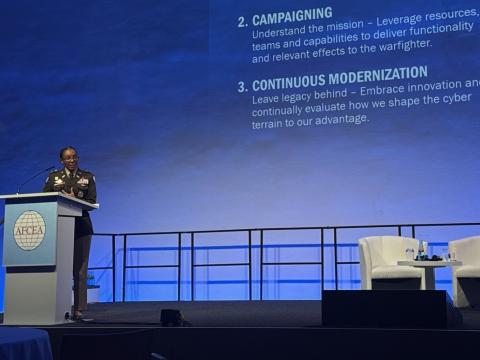Diversity Colors Asia-Pacific Landscape
 |
Gen. Stalder (l) cuts a ribbon with Luvsanvandan Bold (c), Mongolian minister of defense, and Tsakhiagiin Elbegdorj, president of Mongolia, at the official opening of a park at the Five Hills training area. The general visited Mongolia as well as other countries in the Asia-Pacific region in August. |
Complexity is at the core of nearly every mission for the U.S. Marines serving in the Asia-Pacific region. Even something as simple as the international dateline must be taken into account when the U.S. Marine Corps plans operations within its area of responsibility. From the communications perspective, the diversity of countries it interacts with poses significant challenges to its network operators and planners.
Leading the Marines in this vast and multifaceted region at U.S. Pacific Command (PACOM) is Lt. Gen. Keith J. Stalder, USMC, commanding general, U.S. Marine Corps Forces, Pacific (MARFORPAC). Gen. Stalder directs all of the Marines from west of the Mississippi River to
In terms of technology, the Marine Corps Network Operations and Security Command operates and maintains the Marine Corps Enterprise Network from its home in
MARFORPAC faces other challenges as well. Language barriers, cultural differences and systems interoperability are part of many of its missions, events and interactions. For example, the organization works with an assortment of military services from many nations that, in technology sophistication terms, span the spectrum from the very advanced and well-equipped Australian military to the sparsely equipped armed services of many developing nations.
Gen. Stalder took command of MARFORPAC in August 2008. During his time there, he has gained a new appreciation and understanding of how the bases, posts and stations support the operating forces, he admits. The organization currently is supporting three major war plans, and it seeks to ensure that each of the bases and stations can support the deploying forces as they train and prepare for deployments. “Though my mission hasn’t changed per se, I think the AOR [area of responsibility] continually changes. It is such a dynamic and challenging environment. None of the elements of national power can be applied in a vacuum,” he offers.
The factors that affect how the organization does business run the gamut. On the general’s priority list of changes in the past year—though not necessarily the most important—is the new
Another change that has affected MARFORPAC during the past 12 months is the global economic downturn. Gen. Stalder relates that he has seen the limits that fiscal restraints have put on national partners in the AOR. However, MARFORPAC still must do business and train with these nations, he adds.
Cyberwarfare is a constant issue and changes every day. The various levels of technological sophistication between countries in the area rear their ugly heads in the virtual world as well. Generally, all of the nations work with the
Natural disasters are a given in this area of the world. Gen. Stalder says PACOM can expect to be called on to assist in providing relief at least twice a year. Major relief efforts require coordination, and the service relies more heavily on networks to connect not only military forces but also government agencies and nongovernmental organizations (NGOs).
Among the changes and challenges the general foresees in the next year is spectrum management. “Spectrum is a matter of sovereignty for every nation. Wherever we may be required to operate, spectrum management and encroachment is going to be a substantial challenge,” he says.
Another looming matter is the shift of the number of troops from
One disaster that also could be categorized as natural would be a widespread H1N1 flu virus outbreak during the coming year. PACOM is watching the spread of this disease very carefully, because some nations are not as prepared as others, and it would not be unusual for the command to receive a call for help.
 |
Communications on the move is a constant requirement for troops in U.S. Pacific Command’s area of responsibility. Gen. Stalder emphasizes, however, that the communications capabilities that these types of vehicles can provide to troops on the move must be secure. |
Other events taking place in the AOR also influence MARFORPAC’s activities. The agreement between the
Information management is another area where the military cannot invest too much time during the coming year. It means asking hard questions about organizations’ internal processes. A tendency to simply put up a Web site still permeates many large organizations; however, this is not true collaboration, which is what is required, Gen. Stalder states. While the military is doing a very good job and has solid networks and information management processes, these must always be evolving, he adds.
During the next 12 months, MARFORPAC will continue to work on interoperability, language/translation technology and collaboration with its higher, coalition and adjacent commands. And operational Internet—not the nonsecure Internet protocol router network (NIPRNET)—will be key to providing support to coalition partners and NGOs as well as to interfacing with the United Nations (U.N.). “The Internet is the only way we are going to be able to exchange support-requirement information from a U.N. entity or from most NGOs. We do not put them on the NIPRNET, so we have to utilize the Internet, but it still needs to be secure,” Gen. Stalder explains.
Information and knowledge management doctrine development has seen significant growth during the past several years, and it will continue to increase during the year to come. Network-centric warfare considerably increases the amount of information that is available at every level of command. “We need to ensure we have the capacity for the staff and commander to understand the information they are viewing and to which they have access,” he states.
To address some of MARFORPAC’s current and future needs, Gen. Stalder notes the need to be able to leverage technologies’ full capability while maintaining security. The ability to communicate while on the move is omnipresent, and information systems’ defense capabilities in mature combat theaters are equally important, he adds.
Requirements specific to the Asia-Pacific AOR include wireless and satellite communications capabilities, bandwidth management tools that can be used across the enterprise, and cross-domain solutions. The organization also needs a reliable and more extensive language/translation capability as well as ensured interoperability among all of its systems.
Industry is one source for solutions to these challenges; however, Gen. Stalder says working with the commercial sector poses an ongoing challenge of its own. What is needed is a solid way to bridge the gap between the users—Marines and sailors—and companies developing new technologies. “Industry asks Marines and sailors, ‘What do you need?’ Chances are that they will answer, ‘What do you have?’ There is a tremendous gap there, and that little exchange has tremendous hidden meaning. You have an industry capability that is tremendous, but they don’t have the understanding of the requirements that the youngster in the field has, and the youngster is limited by what he or she knows about technology,” he explains. This is a situation that operational commanders need to address, he adds.
Defense Department leadership plans to bridge this gap are only the first step. Industry must then confront a massive, staggering bureaucracy in the acquisition world “that squeezes the juices out of everything in its path,” Gen. Stalder says. Today, even urgent need requests have become encumbered with the “glacial processes of formal acquisition programs” during the past few years, he emphasizes.
The general recommends that those in charge of procurement not be afraid to take risks. “We’ve reduced our acquisition process to an airtight system guaranteed not to make any mistakes. If we want to be aggressive about technology, we must be willing to make mistakes. We are playing not to lose instead of playing to win, and there is a cost for that,” the general maintains. When technology users are brought into the mix sooner in the development process, solutions will be available to warfighters sooner, and the technology will be used more effectively on the battlefield, he adds.
“There is no one-size-fits-all solution that can meet all the challenges that face us in the Pacific theater of operations. All
WEB RESOURCES
U.S. Marine Corps Forces, Pacific: www.mfp.usmc.mil




Comments